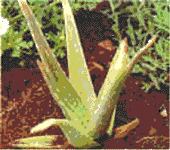Aloes
| |
Egyptology Articles
Herbs and Aroma
Alternative
Medicine
Aroma Therapy
|
|
The Aloes were found in
Egypt from a long time ago. It is still present in Egypt where some religious
groups consider it a symbolic plant. Its Botanical name is Aloe Perryi or Aloe
vera. Its common names are
spiked
aloes or cape aloes, also called Curacao or Socrotine aloes, first-aid herb,
healing herb, medicine plant. Its Arabic name is Sabar.
Aloes are found from Arabia in the North
to Madagascar in the East and Southern Africa in the South. Aloes occur
naturally only in Africa. In Mexico, where Aloe vera escaped from
cultivation, it has been naturalised. They have been introduced into the
West Indies (where they are extensively cultivated) and into tropical countries,
and will even flourish in the countries bordering on the Mediterranean.
Aloes was known by the Greeks as early as 4th century B.C. It was
produced in the island of Socotra and the drug was used by Dioscorides, Celsus and Pliny, as well as by
the later Greek and Arabian physicians.
In the tenth century the drug was imported into Europe by way of the
Red Sea and Alexandria. In the early part of the seventeenth century,
there was a direct trade in Aloes between England and Socotra. |
 |
| |
|
The part used are
the leaves. The drug Aloes consists of the liquid exuded from the
transversely-cut bases of the leaves of various species of Aloes, evaporated to
dryness.
The fleshy leaves
of the true Aloe contain near the epidermis or outer skin, a row of
fibrovascular bundles, the cells of which are much enlarged and filled with a
yellow juice which exudes when the leaf is cut. When it is desired to collect
the juice, the leaves are cut off close to the stem and so placed that the juice
is drained off into tubs. This juice thus collected is concentrated either by
spontaneous evaporation, or more generally by boiling until it becomes of the
consistency of thick honey. On cooling, it is then poured into gourds, boxes, or
other convenient receptacles, and solidifies.
Aloes require two
or three years' standing before they yield their juice. In the West Indian Aloe
plantations they are set out in rows like cabbages and cutting takes place in
March or April, but in Africa the drug is collected from the wild plants.
The juice of aloe leaves contains the purgative aloin. Today the various
drug-yielding species, e.g., A. vera and A. chinensis, are still
used for their traditional medicinal properties as well as for X-ray-burn
treatment, insect repellent, and a transparent pigment used in miniature
painting; cords and nets are made from the leaf fiber. In ancient times the
juice was used in embalming.
|

|
|
|
The constituents of
aloe are mainly two aloin compounds, barbaloin and isobarbalion, as well as
amorphous aloin, resin and aloe-emodin in differing proportions. Aloin, is
present in varying amounts according to source, a neutral principle, chiefly
from Curacao and Socrotine aloes, barbaloin (in Barbados aloes), resin (30-50
percent), emodin (the purgative principle of aloes)(8 percent), a volatile oil
(very slight), and ash (1 to 4 percent). The resin is composed of esters of
various acids, cinnamic acid (obtained also from cinnamon), and cumaric acid
(found in the tonka bean as the odoriferous principle). The ash consists of
potassium and magnesium.
Uses
Mostly the uses of Aloe are medicinal uses.
The drug Aloes is one of the best and well
known purgatives used. It is quite safe and exerts its action upon the large
intestine in 15 to 18 hours. Also it is useful as a vermifuge.
It is a
bitter tonic, laxative, or purgative
according to dose, emmenagogue, antihelminthic, stomachic, hepatic and vermifuge
(ascarides), used in constipation, dyspepsia, menstrual suppressions and piles.
It is generally given in pill form, combined
with anodynes and carminatives, also in liquid form. If given to nursing
mothers, it causes purging in the suckling infant. It acts particularly, on the
lower bowel, the same as cascara.
It enters into thousands of patent medicines, pills and tablets.
Aloes is also used to increase the body’s immune system. This helps the body to
decrease bleeding, damage and leakage on the intestinal wall. It is a potent
anti-inflammatory agent. It helps to rebuild the intestinal mucosa lining.
Aloes helps to heal and accelerates the tissue
healing process thus it is used to treat minor burns, abrasions and skin
irritations.
Aloe is also used by the Arabs to decrease
diabetes, thus it has an anti-diabetic effect.
Externally, apply the fresh transparent gel
from the leaves to scalds and sunburn, blisters, scrapes, and acne to promote
healing and prevent infection.
Aloes is the purgative in general uses for
horses, it is also used in veterinary practice as a bitter tonic in small doses,
and externally as a stimulant and desiccant.
Aloes are
well known succulents, not just for their beauty but for their medicinal
properties as well. You could find aloe vera in skin-care products, hair
shampoo, vitamins and supplements.
|
You may freely reprint this article
or place it on your website by
adding this statement: Courtesy of www.kingtutshop.com
|
_________________________________

